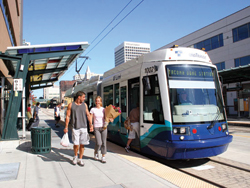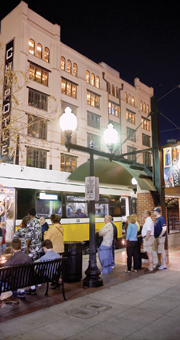Michigan in Motion
Building the Case
Thriving metropolitan regions around the world have multi-modal transportation systems that connect and support all users, from pedestrians and bicyclists to public transit riders and auto drivers. In order to compete, Michigan must also offer a complete transit-and-transportation system that works seamlessly to move people. Shifting our investment from a purely auto-based approach is essential as we strive to keep and attract talent through the development of our places.

the need to make changes that accommodate an aging populace and trending population shift back to metropolitan centers.
Road systems in Michigan are primarily maintained through a combination of federal and state funding, although local units are increasingly being called upon to supplement the shortfalls.
Michigan continually risks losing out on the federal match. Each year, the State has managed to cobble together the required match funds by raiding other pots of money or implementing budget tricks. However, these are not real solutions and if policy makers don’t act soon, our lack of progress on this issue will result in a dis-mantling of the inadequate transportation network that exists today—a 180-degree turn from the modern 21st century system the State needs to be developing.
Michigan needs real increases and new funding mechanisms, and must ensure that this new investment is prioritized in full-service communities and regions. Policy makers must use the current state and federal focus on transportation to propel this from an abstract discussion into real and significant change. We must prioritize and promote transportation and mass transit, road diets, Complete Streets, and recreational opportunities that increase mobility and connectivity. Research shows this is an essential component of successful regions worldwide, so there is simply no time to waste.

Proposed Policy Actions
Transportation, including transit and non-motorized pathways, are an essential component of sustainable places. They must be funded appropriately to yield benefits that other tools, such as Road Diet designs and Complete Street programs provide. Therefore, we propose the following recommendations:
-
Realign the formula of Michigan’s Public Act 51 of 1951 that is utilized by MDOT to distribute transportation dollars to the various road agencies. The Act 51 formula is based on outdated criteria that do not reflect the economics of maintaining a modern transportation network. Its simplistic basis is driven by miles of road, traffic volumes and, to some extent, population. It ignores metropolitan needs and roadway characteristics, and fails to allow for project cost variability due to such factors as lane miles, age of infrastructure, and the presence of underground utilities.
-
Alternatively, amend PA 51 to prioritize the spending of any new transportation revenues coming into the system from increased fuel tax or vehicle registration revenues on transportation systems in already developed areas. Currently, the roughly $3 billion that Michigan spends on roads, bridges, and transit is split (after earmarks for economic development projects, transit, and bridges) with 39.1 percent going to the MDOT system, 39.1 percent to the county road system, and 21.8 percent to cities and villages. Instead of basing distribution on the type of road agency, these new monies should be spent based on criteria similar to that used by the Local Bridge Advisory Board, which recognizes various factors in a project’s
cost and the economic value of a project with an eye towards stimulating economic opportunities. This will allow the Act to account for more specific details about the infrastructure systems being managed by the various road agencies.
-
There must also be a greater emphasis on transit development through increasing revenues. The economic impact is indisputable. Leaders in Los Angeles, California and Cleveland, Ohio have shown the economic activity that follows transit development shows a return on investment that is 3 and 4 times the initial public allocation.
-
Support a gas tax increase to ensure that Michigan is able to meet the federal match going forward, and begin to plan for the state’s infrastructure reconstruction using a 21st century model that focuses on strong local networks connecting people in a meaningful way that accommodates their mobile lives. A gas tax increase to 37 cents which includes parity for diesel gas would generate approximately $950 million.
-
Do not allow the State to divert funding passed on by the federal government for Transportation Alternatives, and require that all of that funding be made available for communities to invest in the talent attraction amenities.
-
Prioritize road diets and livable streets with increased revenues allocated for projects that help develop a sense of place in their neighborhoods. The “road diet” is a tool to help communities deal with the excess of asphalt promulgated in the past several decades. A road diet converts a large multi-lane corridor into a two- or three-lane road with a turn lane and/or bike lanes. This action creates a more livable street that promotes improved safety, economic development, and commercial activity. Road diets are very applicable in areas which have lost population or need to realign with modern transportation priorities in order to revitalize. In other words, many Michigan communities could benefit from this type of activity.
Download: Partnership for Place: An Agenda for a Competitive 21st Century Michigan
 cost and the economic value of a project with an eye towards stimulating economic opportunities. This will allow the Act to account for more specific details about the infrastructure systems being managed by the various road agencies.
cost and the economic value of a project with an eye towards stimulating economic opportunities. This will allow the Act to account for more specific details about the infrastructure systems being managed by the various road agencies.